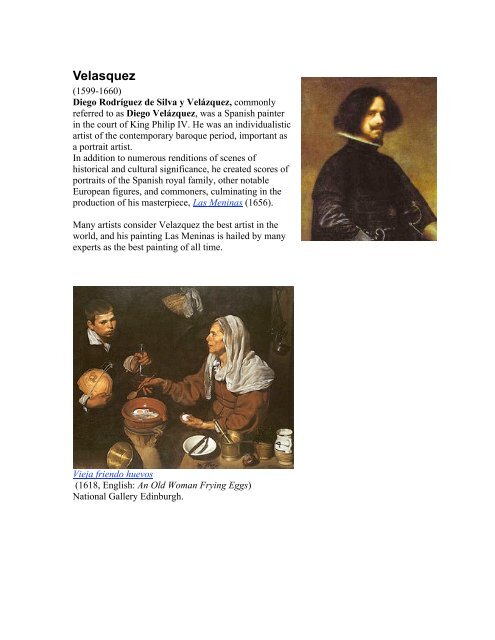velasquez
velasquez
velasquez
- No tags were found...
You also want an ePaper? Increase the reach of your titles
YUMPU automatically turns print PDFs into web optimized ePapers that Google loves.
Velasquez(1599-1660)Diego Rodríguez de Silva y Velázquez, commonlyreferred to as Diego Velázquez, was a Spanish painterin the court of King Philip IV. He was an individualisticartist of the contemporary baroque period, important asa portrait artist.In addition to numerous renditions of scenes ofhistorical and cultural significance, he created scores ofportraits of the Spanish royal family, other notableEuropean figures, and commoners, culminating in theproduction of his masterpiece, Las Meninas (1656).Many artists consider Velazquez the best artist in theworld, and his painting Las Meninas is hailed by manyexperts as the best painting of all time.Vieja friendo huevos(1618, English: An Old Woman Frying Eggs)National Gallery Edinburgh.
The Waterseller ofSeville Velázquez1618-1622 Oil oncanvas 105 × 80 cmApsley House,LondonThe Waterseller ofSeville epitomizesall that Velázquezset out to achieve inthe genre paintings.It is widely said tobe the greatest of allhis Seville paintings.The subject of thepainting is thewaterseller. This wasa common trade forthe lower classes inVelázquez's Seville.The still, calm scene- a typical quality ofhis genre scenes and,indeed, much ofVelázquez's work -is remarkable for the depiction of the seller. His pensive face, battered by its direct exposureto sunlight, deeply scarred with the wrinkles of age, speaks of long years of experience. Hisshort shaved hair and old plain clothes give him the appearance of a monk, or a saint, or aneccentric philosopher. He gazes into nothing, indicating deep thought, almost unaware ofthose around him. It is unnecessary for him to focus on his job, he is elsewhere: in a worldinaccessible to both us and the boy.In this picture, we see evidence of Velázquez's deep respect for the poor. He entitles the elderlyseller to immense dignity, despite his lowly place in society. Another proponent of this idea wasCaravaggio, who significantly influenced this painting. Caravaggio was perhaps the most famouschampion of the poor, going against the idealistic trends of Mannerism and the Renaissance
Juan de Pareja (1650)Oil on canvas 81.3 × 69.9 cmMetropolitan Museum of Art, New York CityIn 1648, as court painter to Philip IV of Spain,Diego Velázquez was sent to Rome to purchaseworks of art, and he brought Juan de Pareja withhim. During his stay in Rome, Velázquez executedan oil portrait of de Pareja which was displayed aspart of a larger exhibition of paintings at thePantheon. The painting "was generally applaudedby all the painters from different countries, whosaid that the other pictures in the show were art butthis one alone was 'truth'."Velázquez painted the Juan de Pareja as an exercise in preparation for his official portrait ofPope Innocent X (next page).The Juan de Pareja is currently on display at the Metropolitan Museum of Art in New YorkCity, which purchased it in 1971. At the time, the purchase price of over $5.5 million set anew record for paintings at auction. This became a source of some controversy both for themuseum and for its director, Thomas Hoving, who spearheaded the effort to acquire the workand considered it one of the finest paintings in the museum's collection. However, art priceshave skyrocketed since the mid-1970s, and the Juan de Pareja could be expected to fetcheasily ten times its purchase price today.
Portrait of Pope Innocent X(1650) Oil on canvas 114 × 119 cm Galleria Doria Pamphili, RomeThe Pope, a ruddy-faced man who would be depicted in the bright pink and crimson robes ofhis office, presented a tricky study in both color and composition. Additionally, since hewould be executing a portrait from life, Velázquez would be forced to work quickly whilestill capturing the essence of Innocent X's character. The Juan de Pareja reflects Velázquez'sexploration of the difficulties he would encounter in the Pope's portrait. To compensate for arestricted palette of colors, Velázquez adopted a loose, almost impressionistic style ofbrushwork to bring an intense vitality to his subject -- a style which would make both theJuan de Pareja and the subsequent portrait of Innocent X two of the most renownedpaintings of his career.
Philip IV in Brown and Silver1631/32. Oil on canvas. National Gallery, London, UK
Equestrian portrait of Count Duke de Olivares1634 Oil on canvas 313 × 239 cm Museo del Prado, MadridPrime Minister of Spain during the reign of Philip IV, the Count is portrayed riding a horse, anhonour generally reserved for monarchs at the time. He wears a plumed headgear and a giltcuirass, and holds a command baton. The composition refers to Olivares' military leadership inthe service of King Philip.
San Francisco Utility Conditions PermitPage 75.4 Whenever the removal or relocation of the Facilities is required under this Permit,Permittee shall, after the removal or relocation of the Facilities, at its own cost and expense,promptly repair, restore and return the Public Right-of-Way in which the Facilities were located,to a safe and satisfactory condition, as Approved by the Director in accordance with applicableLaws and standard requirements. If Permittee does not return the affected site to a safe andsatisfactory condition, City shall have the option to perform or cause to be performed suchreasonable and necessary work on behalf of Permittee and charge the actual costs incurred,including but not limited to administrative costs, to Permittee. Upon the receipt of a demand forpayment by City, Permittee shall reimburse City for such costs.6.0 EXCAVATION PERMIT(S).6.1 Prior to commencing any work in the Public Right-of-Way, Permittee shall apply forand obtain excavation permits and all other required regulatory permits in accordance with theLaws then in effect, for each construction project or other activity to be performed within thePublic Right-of-Way, unless such project or activity is necessary on an emergency basis pursuantto Section 368, or any successor provision, of the San Francisco Public Works Code. Permitteeshall pay all Fees required as a condition precedent to the issuance of any regulatory permits inaccordance with the applicable rates and charges then in effect.6.2 Permittee shall not install overhead Facilities in the Public Right-Of-Way withinLegislated Underground Districts, pursuant to San Francisco Public Works Code Section 911, orin areas where utility services are provided by rear yard feeds.6.3 Permittee shall maintain current, accurate and complete plans and record drawingsshowing, in detail, the exact location, depth, and size of any Facilities constructed or installed inthe Public Right-of-Way in relation to other facilities in the Public Right-of-Way. Upon demand,such plans and record drawings shall be delivered to City in a form to be determined by theDirector pursuant to the following timeframes: (a) immediately in the event of an emergency; (b)within five (5) working days for requests of ten (10) or fewer records; and (c) within ten (10)working days for requests of more than ten (10) records.6.4 Any method of excavation other than open trenching may be used only uponApproval by the Director.7.0 JOINT PARTICIPATION WITH DPW AND OTHER PERMITTEES.7.1 Permittee shall participate in the Department’s Pavement Management Program andthe Committee for Utility Liaison on Construction and Other Projects ("CULCOP") establishedby Section 5.63 of the San Francisco Administrative Code, or any successor organizationestablished by the Department, in the manner prescribed by the DPW Director. Permittee shalltake all reasonable precautions to protect all other facilities located under the street.7.2 In accordance with the provisions of Chapter 3.1 of Division 5 of Title I of theGovernment Code of the State of California (Section 4216 et seq.), Permittee as an operator of asubsurface installation shall obtain and maintain membership in a regional notification center(e.g., Underground Service Alert - Northern California), and shall otherwise comply with theprovisions of the referenced chapter, division and title upon demand. Permittee shall furnishwritten proof of such membership to the Director within two (2) Days. Repeal of any Lawrequiring such membership shall not negate Permittee's obligation to maintain such membership.C:\WINDOWS\DESKTOP\SF UCP Application.doc
The Dwarf Francisco Lezcano c. 1643-45Oil on canvas. Museo del Prado, Madrid, Spain.Though few ladies of the court of Philip have been depicted, Velázquez painted several of hisbuffoons and dwarfs. Velázquez appears to represent them with respect and sympathetically, asin El Primo (1644, English: The Favorite), whose intelligent face and folio with ink-bottle andpen by his side show him to be a wiser and better-educated man than many of the gallants of thecourt.
Don Sebastián de Morra c. 1645Oil on canvas. Museo del Prado, Madrid, Spain.
Las Meninas1656–57, Oil on canvas, 318 x 276 cm, Museo del Prado, Madrid(Spanish for The Maids of Honour)The work's complex and enigmatic composition raises questions about reality and illusion, andcreates an uncertain relationship between the viewer and the figures depicted. Because of thesecomplexities, Las Meninas has been one of the most widely analyzed works in Western painting.
Las Meninas shows a large room in the Madrid palace of King Philip IV of Spain, and presentsseveral figures, most identifiable from the Spanish court, captured, according to somecommentators, in a particular moment as if in a snapshot. Some figures look out of the canvastowards the viewer, while others interact among themselves.The young Infanta Margarita is surrounded by her entourage of maids of honour, chaperone,bodyguard, and two dwarfs. Just behind them, Velázquez portrays himself working at a largecanvas. Velázquez looks outwards, beyond the pictorial space to where a viewer of the paintingwould stand.A mirror hangs in the background and reflects the upper bodies of the king and queen. The royalcouple appear to be placed outside the picture space in a similar position to that of the viewer,although some scholars have speculated that their image is a reflection from the paintingVelázquez is shown working on.




